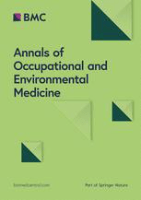
Annals of Occupational and Environmental Medicine
Scope & Guideline
Advancing Health in Every Workplace and Environment
Introduction
Aims and Scopes
- Occupational Health and Safety:
Research on the health and safety of workers across various industries, including the impact of hazardous exposures and workplace conditions on physical and mental health. - Environmental Health Impacts:
Studies examining the relationship between environmental factors, such as pollution and chemical exposure, and health outcomes in occupational settings. - Workplace Psychology and Behavior:
Exploration of psychological factors affecting workers, including stress, burnout, job satisfaction, and their relationship with overall health and productivity. - Epidemiological Studies:
Epidemiological research analyzing the prevalence and incidence of health issues among different occupational groups, often utilizing large-scale surveys and cohort studies. - Policy and Regulation Analysis:
Evaluation of occupational health policies, regulations, and their effectiveness in improving worker safety and health outcomes.
Trending and Emerging
- Impact of Remote Work and Telecommuting:
In light of the COVID-19 pandemic, there is a growing focus on the health implications of remote work, including job demand, work-life balance, and mental health outcomes associated with telecommuting. - Psychosocial Risks and Mental Health:
Increased attention to the psychological impacts of work-related stress, burnout, and mental health disorders among workers, particularly in high-stress occupations. - Chronic Health Conditions Related to Work Patterns:
Emerging studies linking chronic health conditions, such as metabolic syndrome and cardiovascular diseases, to specific work patterns, including shift work and long working hours. - Chemical and Environmental Exposures:
A rising number of studies are focusing on the health effects of exposure to specific chemicals and pollutants, particularly in occupational settings, reflecting increased awareness of environmental health impacts. - Intersection of Employment Types and Health Outcomes:
Research examining the health implications of non-standard employment types, such as gig and contract work, highlighting the unique challenges faced by these workers.
Declining or Waning
- Traditional Occupational Diseases:
Research on classic occupational diseases, such as silicosis and asbestosis, has seen a decline as newer health issues gain attention, reflecting a shift towards contemporary workplace hazards. - General Work-related Musculoskeletal Disorders:
While still important, studies specifically focusing on generic musculoskeletal disorders without considering specific occupational contexts or interventions have decreased, indicating a trend towards more nuanced research. - Historical Case Studies:
There has been a reduction in the number of historical case studies examining past occupational health incidents, as the focus shifts towards current and emerging health risks. - Non-specific Environmental Health Issues:
Research that lacks a direct connection to occupational health contexts, such as general environmental pollution studies, appears to be less frequent, suggesting a tightening of the journal's scope towards more relevant occupational contexts.
Similar Journals
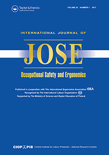
International Journal of Occupational Safety and Ergonomics
Exploring the forefront of ergonomics and safety.International Journal of Occupational Safety and Ergonomics, ISSN 1080-3548, is a leading multidisciplinary journal published by TAYLOR & FRANCIS LTD with a dedicated focus on advancing research and practices in occupational safety and ergonomics. Since its inception in 1995, this journal has provided a platform for the dissemination of innovative studies that address critical issues in public health, environmental and occupational health, and safety research. Recognized for its rigorous peer-review process, the journal holds a respectable position in the Q2 quartile rankings across multiple categories as of 2023, reflecting its impact and relevance within the academic community. It ranks 24th out of 109 in Safety Research, 198th out of 665 in Public Health, and 66th out of 207 in Safety, Risk, Reliability and Quality, showcasing its influence in these essential fields. The journal's broad scope aims to bridge gaps between research and application, ensuring that findings contribute to effective safety practices in various industries. While not an Open Access journal, the International Journal of Occupational Safety and Ergonomics remains an invaluable resource for researchers, professionals, and students seeking to stay informed about the evolving landscape of occupational safety. Its headquarters are located in Abingdon, England, serving as a conduit for scholarly communication in this vital area of study.

Safety and Health at Work
Fostering innovation in safety and health practices.Safety and Health at Work is a prominent academic journal published by Elsevier, dedicated to advancing the fields of safety research, public health, and occupational health. Since its inception in 2010, the journal has established a robust Open Access platform, allowing for a wide dissemination of high-quality research aimed at improving safety standards and health practices globally. Based in South Korea, the journal is housed at RADARWEG 29, 1043 NX AMSTERDAM, NETHERLANDS, and has garnered a notable reputation with an impressive ranking in various categories, achieving Q1 status in Safety Research and Q2 in related fields such as Public Health and Chemical Health and Safety. With an impact factor reflective of its influence—ranking within the top percentiles of Scopus in Safety and Chemical Engineering—the journal serves as an essential resource for researchers, professionals, and students committed to fostering safer and healthier workplace environments. The convergence of multiple disciplines enriches its contributions, making it a vital platform for innovation and collaboration in safety practices and policies.

Medicina del Lavoro
Elevating standards in public health and safety.Medicina del Lavoro, published by MATTIOLI 1885, is a distinguished academic journal that has been a pivotal resource for the fields of medicine and public health since its inception in 1947. With an ISSN of 0025-7818, this journal focuses on disseminating high-quality research relevant to environmental and occupational health, positioning itself in the Q2 category for both Medicine (miscellaneous) and Public Health, Environmental and Occupational Health. Its notable Scopus ranking places it within the top 69th percentile of its field, reflecting its commitment to scholarly excellence. While the journal is not open access, it offers a range of informative articles, including original research, reviews, and case studies, that are essential for researchers, professionals, and students committed to advancing their understanding of workplace health and safety. With articles converging up to 2024, Medicina del Lavoro continues to illuminate critical issues and foster discussion within the global health community.
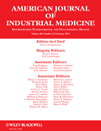
AMERICAN JOURNAL OF INDUSTRIAL MEDICINE
Elevating Standards in Occupational Health ResearchAMERICAN JOURNAL OF INDUSTRIAL MEDICINE, published by Wiley, stands out as a premier journal dedicated to the field of industrial medicine, emphasizing comprehensive research related to occupational health and safety. With an impressive impact factor, the journal holds a distinguished position in its category, ranked in the Q1 quartile for Public Health, Environmental and Occupational Health as of 2023. It has garnered respect within the academic community, ranking #141 out of 665 in Scopus, placing it in the 78th percentile. Research published here spans various topics from epidemiological studies to interventions aimed at improving worker health outcomes, appealing to a diverse audience of researchers, professionals, and students alike. The AMERICAN JOURNAL OF INDUSTRIAL MEDICINE is committed to advancing knowledge and practice in industrial health, fostering an environment where important discussions and discoveries can shape the future of occupational health globally.

OCCUPATIONAL AND ENVIRONMENTAL MEDICINE
Connecting research to real-world health solutions.OCCUPATIONAL AND ENVIRONMENTAL MEDICINE is a leading academic journal dedicated to the field of public health, with a specific emphasis on environmental and occupational health. Published by the esteemed BMJ PUBLISHING GROUP, this journal has established itself as a crucial resource for researchers, professionals, and students alike, achieving a remarkable impact factor that reflects its high-quality research contributions. With a distinguished Q1 ranking in its category and a strong position in Scopus rankings—placing it at #59 out of 665—this journal showcases top-tier studies and findings from 1994 to its anticipated convergence in 2024. Set in the United Kingdom, the journal aims to advance understanding and practices relating to health in the workplace and environmental settings, making it an indispensable platform for the dissemination of knowledge in this vital area. Although not an open-access journal, it provides a valuable repository of articles that influence policy and practice worldwide, ensuring that critical information is accessible to those dedicated to promoting safer, healthier working and living environments.
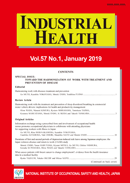
INDUSTRIAL HEALTH
Bridging Research and Practice in Industrial SettingsINDUSTRIAL HEALTH is a premier journal dedicated to the dissemination of innovative research in the fields of public health, environmental and occupational health, as well as toxicology and mutagenesis. Published by the National Institute of Occupational Safety and Health in Japan, the journal has been a critical resource for over six decades, covering essential topics from 1963 to the present day. With an impressive placement in the second quartile (Q2) of the Public Health, Environmental and Occupational Health category and a third quartile (Q3) in Health, Toxicology, and Mutagenesis, it is recognized for its significant contribution to advancing knowledge and improving practices within the industry. While not an open-access journal, INDUSTRIAL HEALTH offers researchers and students access to a wealth of knowledge through its rich archive of articles, fostering a deeper understanding of health and safety challenges in industrial settings. The journal’s dedication to high-quality research and its strategic role in promoting occupational safety make it an invaluable asset for professionals seeking to enhance health standards and safety protocols worldwide.
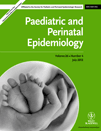
PAEDIATRIC AND PERINATAL EPIDEMIOLOGY
Leading the Charge in Epidemiological ExcellencePAEDIATRIC AND PERINATAL EPIDEMIOLOGY is a premier journal in the field of epidemiology, published by WILEY. Established in 1987, it provides an invaluable forum for researchers, professionals, and students interested in the intersections of pediatric health and perinatal epidemiology. With its strong reputation, the journal holds a distinguished Q2 ranking in Epidemiology and a Q1 ranking in Pediatrics, Perinatology, and Child Health as of 2023, indicating its influential role in advancing knowledge and practice. The journal is indexed in Scopus, boasting impressive rankings, including Rank #52 out of 330 in Pediatrics, with an 84th percentile standing, demonstrating its significant impact in the field. Although not an Open Access journal, PAEDIATRIC AND PERINATAL EPIDEMIOLOGY equips its readers with high-quality research aimed at improving child and maternal health outcomes, making it a vital resource for anyone committed to advancing public health in these critical areas.
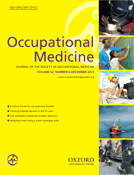
OCCUPATIONAL MEDICINE-OXFORD
Championing Worker Wellness through Cutting-Edge ResearchOccupational Medicine-Oxford is a leading journal in the fields of public health and occupational health, published by Oxford University Press. With an ISSN of 0962-7480 and an E-ISSN of 1471-8405, this esteemed journal has been disseminating critical research findings since its inception in 1948. Ranked in the Q2 category for both Medicine (miscellaneous) and Public Health, Environmental, and Occupational Health, it occupies a significant spot in the academic community, with a Scopus ranking of #147 out of 665 in its categories, placing it within the 77th percentile. The journal aims to enhance the understanding of occupational health issues and promote practices that improve worker safety and well-being. As a vital resource for researchers, professionals, and students alike, Occupational Medicine-Oxford provides insights into emerging trends, comprehensive reviews, and original research articles that pave the way for future innovations in occupational health strategies. Explore the journal for the latest developments in this critical field, and gain access to a wealth of knowledge that can make a meaningful impact on public health policies and occupational practices worldwide.
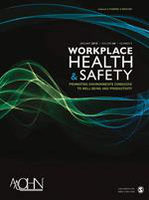
Workplace Health & Safety
Enhancing health and safety standards for a better workplace.Workplace Health & Safety is a prominent peer-reviewed journal published by SAGE Publications Inc, aiming to advance the field of occupational health and safety through rigorous research and practical applications. With an impact factor reflecting its significant contributions to the fields of nursing and public health, this journal ranks in the second quartile (Q2) for both Nursing (miscellaneous) and Public Health, Environmental and Occupational Health, showcasing its standing among peers. Since its inception in 2003, the journal has been committed to disseminating insights that enhance workplace safety and health practices, making it a vital resource for researchers, professionals, and students alike. Readers can access a wealth of knowledge through its open access option, fostering a broader understanding and discussion around critical health and safety issues in various work environments. With a consistent commitment to excellence and relevance, Workplace Health & Safety is essential for anyone dedicated to improving workplace environments and promoting health and safety standards.
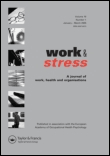
WORK AND STRESS
Innovating Strategies for a Healthier Work EnvironmentWORK AND STRESS is a premier journal in the field of applied psychology, published by Taylor & Francis Ltd, and holds an impressive Q1 ranking among its peers, reflecting its high standards and significant impact in the domain. With an ISSN of 0267-8373 and an E-ISSN of 1464-5335, this journal has been a crucial platform for scholarly discourse since its inception in 1987, continuously contributing valuable insights into the intricate relationship between work environments and psychological well-being. Targeted at researchers, professionals, and students, WORK AND STRESS features empirical studies, reviews, and theoretical essays, promoting a multidisciplinary approach to understanding the various stressors in workplace settings and their effects on mental health. The journal aims to bridge academia with practical applications, enhancing strategies for stress management and improving overall workplace dynamics. Readers can expect rigorous research, innovative findings, and valuable methodologies that resonate across diverse professional fields.